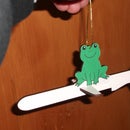Introduction: Make a Meta-book
Everyone who reads books for pleasure has had the let down which comes from opening a book and finding that it wasn't as good as they'd hoped.
Fortunately, you can now make opening _any_ [1] book as pleasurable as finding your favourite book of all time, simply by hollowing out a non-favourite book and inserting a different one [2].
In the precise instance of this project, Steel Beach is not my least-favourite book, but the copy which I recently bought had been mis-bound and the first two hundred pages had been repeated while another two hundred pages had been omitted. That has got to be the largest stutter in history.
[1] any book which is sufficiently physically larger than your favourite book. If your favourite book is Audubon's Birds of America then you might be a while looking.
[2] actual pleasure of finding the internal book is dependent on the book inserted.
Step 1: Tools and Materials
There are a lot of projects which hollow out books, but this one is a lot quicker than most as it doesn't require you to slice a hole in hundreds of pages with a scalpel. Using a jigsaw is much faster and also leads to a neater and more consistent result.
I used a power drill and electric jigsaw, but the project can be easily completed with only handtools.
Step 2: Clamp Pages Together
Insert the two sheets of thin scrap ply into the larger book. Use the smaller book as a spacer to ensure that there are just enough pages between them to give the required cavity.
Most hollowed out books end up being really obvious as the covers cave in around the hole, so take care to match the depth of paper between the plywood sheets to the thickness of the insert book.
Butt the sheets of ply as far in to the spine as you can without breaking the book, and use a couple of clamps to hold it together.
Drill a couple of clearance holes which will allow the long screws to pass through. They need to be in the middle of the page, clear of the line which will be cut, but exact placement isn't that important.
Drive the screws through the clearance holes and into the scrap block of thick plywood. Tighten them right down so that the heads are flush against the surface of the thin ply scrap so that the jigsaw can pass over them.
Step 3: Finger Hole and First Cut
Grip the thick piece of scrap ply in a vice, well offset so that the jigsaw blade will not foul on the vice.
Mark around the inner book, leaving as much paper as possible around all four edges.
Using a large spade drill bit, drill a hole in the middle of the top line. This will give room to slip a fingertip in to free the stored book. Something around 3/4" (18mm) should be fine, but your fingers may vary.
Once that's through, use that hole to start the jigsaw cut.
Since the internal piece is just being thrown away, there's no need to get fancy at the corners: just hack away a wider and wider cut until you can turn the jigsaw around and approach the long sides.
Take care to not cut past the point where the jigsaw blade is free so that you don't damage your vice, your saw or your saw-blade.
Step 4: Completing the Cut
Slacken the vice, and move the assemblage to the other end of the jaws, again making sure that you'll have enough room to insert the jigsaw.
Leave the cut at the spine until last as it will have more strength to support everything, and before you make that last cut, use a couple of clamps to hold the outside and inside together.
Once the cut has been joined, lift the cut book away, leaving the bundle of pages together. Remove the screws and you can dump the cut pages into the paper recycling. If you have _any_ idea of something useful to do with the block of pages, then please suggest it to me, or else do it and post an Instructable!
Step 5: Lining
My cut books had always flopped a bit until I came across this Instructable by natecummings, which used duct tape to hold everything together in really interesting way.
I wanted something a bit softer, so I used adhesive-backed felt.
Measure the hole, and make a template. To line the hole you'd need a cross-shape, but to give a little frame around the top I added a centimetre to the length of the arms and then flared that outwards by 45 degrees.
Sticking this in place is a bit fraught, I scored the backing paper in a saltire, and then peeled back the four points. this allowed for easy centring without too much risk of a sticky disaster.
Since the felt can stretch as it is applied the concealment of minor crimes isn't too hard. A final trim around the outside of the felt can be helpful.













